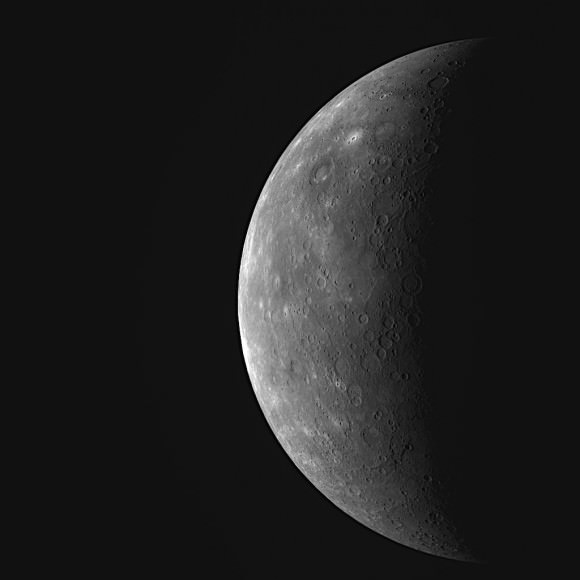[/caption]
The MESSENGER spacecraft went into safe mode just before its closest approach of Mercury on Sept. 29. Although the instruments were taking data as the spacecraft came near the planet during this third flyby of the mission, after going into safe mode, no further data or pictures were obtained. This means the expected science investigations from the flyby were not executed. However, as Emily Lakdawalla pointed on in the Planetary Blog, the most important purpose of this flyby was the last gravity assist that will allow MESSENGER to enter orbit in 2011, and to that end, the flyby was a complete success. Additionally, the images taken during the approach are of the 5% of Mercury that was previously unseen, as in the image above of this unnamed basin. See more images from the approach below.

MESSENGER skimmed just 142 miles (228 km) above Mercury at closest approach, and then whipped behind the planet for the gravity assist. During the operation, five MESSENGER “fellows” or master teachers were reporting the flyby live via Twitter. Gene Gordon (Porchdragon on Twitter) reported that unexpectedly, the signal dropped from MESSENGER before the expected signal blackout while flying on the other side of Mercury: “Suddenly room got quiet and people hovering near computers. Unexpected signal drop just occurred. Sense of nervousness seems to have happened.”
Read Gene Gordon’s blog post about his experiences.
The MESSENGER team had to wait over 50 minutes until the spacecraft emerged from behind Mercury, and were relieved to be able to resume contact. As of Wednesday morning, the spacecraft was operating normally, and the reason for the signal drop was unclear. At a briefing, MESSENGER team members said the spacecraft went into safe mode when it entered Mercury’s shadow and tried to switch to battery power. The team is still looking into why this anomaly occurred.
A little less than half of the”extra” science goals for the flyby were accomplished. See our previous article on the science goals for the flyby. Following this flyby. only the polar regions of Mercury have never been seen.

MESSENGER made its closest approach on Tuesday at about 5:55 p.m. EDT (2155 GMT), zooming at speeds of about 12,000 mph (19,312 kph). Mercury’s gravity was expected to slow MESSENGER by about 6,000 mph (9,656 kph) during the flyby and place it on track to enter orbit of Mercury in March 2011.
See all the images acquired by the third flyby here.
Learn more about MESSENGER and the two previous flybys which occured in 2008 here.
Lead image caption: his unnamed impact basin was seen for the first time yesterday during MESSENGER’s third flyby of Mercury. The outer diameter of the basin is approximately 260 kilometers (160 miles). This basin has a double-ring structure common to basins with diameters larger than 200 kilometers (about 125 miles).
Additional information from Jeff Goldstein on Twitter (doctorjeff) was also used in this article


Crumbs!
That’s a bit of a hair-em’ scare-em’. Micro-meteorite? Radiation? Power? Atmosphere?
We’re all sitting here with bated breath…
Ooh, that second picture is now my fantastic new wallpaper.
Too bad about the safe mode thing.
Assuming it wasn’t any problems with the batteries, it’s another of those annoying programming faults like the one that silenced instruments on Galileo on approach. That’s what you have to live with in today’s complex systems.
[I read that the fault tolerant systems in today’s probes actually press separate software “computers” into the same hardware to save weight, power and cost. I.e. it’s not only separate threads but as nearly separate cores as you can make them (as I understand it), locking one “OS” up will not affect the rest.]
Glad to hear everything’s ok. The images it took are amazing.
Ouch! And BUMMER! Sheesh… been waiting all this time and then PLOP~ Grrrrr… The awesome images can only hint at what was lost? Here’s hoping the rest of the mission goes smoothly.
I wonder if the current (No pun intended) solar minimum and subsequent high gamma ray count has anything to do with the ‘signal drop’?
Working with some fairly complex electronic/computer systems equipment myself, I can testify that when unexpected things like this happen to your remote comms, it is instant ‘butterflies in the stomach’. It must have been quite the nervous 50 minute wait until comms could be re-established!
Oh well – we’ll just have to make do with what we have. Considering the flyby hit the required windows etc and we’re now on track for the orbit insertion, I’d say that this was almost a complete success…
Interesting how the MRO mission has had a similar series of ‘signal drops’ and has had to be rebooted several times recently….